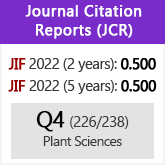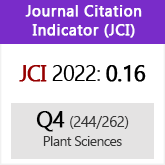Limonium vigoi (Plumbaginaceae), a new tetraploid species from the Northeast of the Iberian Península
DOI:
https://doi.org/10.3989/ajbm.1998.v56.i2.233Keywords:
Plumbaginaceae, Limonium, taxonomy, apomictic taxa, Northeast of the Iberian PenínsulaAbstract
A new tetraploid agamic species, Limonium vigoi, is described from coastal populations of the Northeast of the Spain (Ebro delta). The new species is related, on morphological grounds, to L. girardianum (Guss.) Fourr. and L. grosii L. Llorens, from which it could be easily discriminated by its retuse leaves, the basal ones usually withered at anthesis, the very short (or even absent) leaf apiculum, the denser and longer (up to 0.7 mm) hairs of the calyx tube and the deeper colour of the corolla. In addition, L. girardianum is triploid, whereas L. vigoi and L. grosii are tetraploid. Limonium girardianum and L. grosii show the same pollen/stigma combination (A/cob type) which differs from that exhibited by L. vigoi (B/papillate type). The types of Limonium girardianum f. retusum Pignatti and L. glaucophyllum Pignatti, two taxa described from the Ebro delta, could not be distinguished from L. girardianum, but they clearly differed from L. vigoi.
Downloads
Download data is not yet available.
Downloads
Published
1998-12-30
How to Cite
Sáez, L., Curcó, A., & Rosselló, J. A. (1998). Limonium vigoi (Plumbaginaceae), a new tetraploid species from the Northeast of the Iberian Península. Anales Del Jardín Botánico De Madrid, 56(2), 269–278. https://doi.org/10.3989/ajbm.1998.v56.i2.233
Issue
Section
Articles
License
Copyright (c) 1998 Consejo Superior de Investigaciones Científicas (CSIC)

This work is licensed under a Creative Commons Attribution 4.0 International License.
© CSIC. Manuscripts published in both the printed and online versions of this Journal are the property of Consejo Superior de Investigaciones Científicas, and quoting this source is a requirement for any partial or full reproduction.All contents of this electronic edition, except where otherwise noted, are distributed under a “Creative Commons Attribution 4.0 International” (CC BY 4.0) License. You may read here the basic information and the legal text of the license. The indication of the CC BY 4.0 License must be expressly stated in this way when necessary.
Self-archiving in repositories, personal webpages or similar, of any version other than the published by the Editor, is not allowed.
















